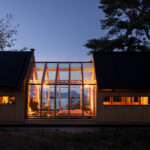On a warm late-summer day, we traveled up from busy New York City to the quiet suburban town that is New Canaan, Connecticut. For anyone who has visited Philip Johnson’s Glass House and the 49-acre property on which it sits, you will remember the imposing gate — two tall trapezoidal stone columns that carry a round steel tube up and down to allow vehicles onto the site — that marks the entrance. Behind it, the first building that one encounters on the property, “Da Monsta,” is a sculptural two-room structure that reveals Johnson’s closeness with Frank Gehry and Peter Eisenman, strong influencers of the works he completed in the later years of his life.

The procession to the Glass House — a famed destination for many who visit this New Canaan property — is slow, winding along a short driveway that leads the visitor through a roundabout of sorts, anchored by Donald Judd’s Untitled, his first concrete work, completed in 1971.
On most days, Johnson’s masterful weekend retreat remains concealed into the landscape until the visitor arrives much closer to its structure. However, as we make our way and our eyes level beneath the branches of thick pine trees, bright red spots become immediately visible against the green foliage, the first glimpse of Yayoi Kusama’s curated intervention on the site.

In celebration of what would have been Philip Johnson’s 110th birthday, as well as the 10th anniversary of the opening of the Glass House site to the public, the Japanese artist presents the third part of the “Yayoi Kusama: Narcissus Garden” landscape series in the heart of Connecticut. Yayoi Kusama: Dots Obsession-Alive, Seeking for Eternal Hope is the name of the installation, which intervenes in three instances of the visit of the Glass House site.

Facing the Glass House is an installment of Kusama’s enormous steel PUMPKIN, created in 2015. The reflective sculpture sits atop a concrete footing where Ellsworth Kelly’s Curve II, a work dating from 1973, was once exhibited.
The perforated walls of the pumpkin give a glimpse of the “Pepsi Red” color coating the inside of the form, a hue that is later reflected on the architecture seen a little farther down the hill.

On the Glass House itself, Kusama has pasted more than 1,200 low-tack adhesive vinyl circles of varying sizes to recreate her famous “infinity room” experience. The intervention strongly alters the usual visit, as the glass walls suddenly become much more tangible and the shadows cast by the sun throughout the day project circular dots on the floor and furniture. Kusama’s obsession seems to reach all corners and objects in the house.
“Would Philip Johnson have had polka dots on the Glass House?” asked our guide from the Glass House organization who walked us around the site. “Maybe not, but it shakes us up.” Irene Schum, the curator for the exhibition, wanted to offer visitors “the unique experience to simultaneously see the world through the eyes of both Philip Johnson and Yayoi Kusama.”

At the foot of the hill, a pond reflects the surrounding nature. It is in this pond that Kusama has recreated Narcissus Garden, which she first presented at the 1966 Venice Biennale. While the original installation consisted of silver-colored plastic spheres — which Kusama, uninvited to the renowned architecture event, was selling to visitors for $2 each — the version that can be seen in the Lower Meadow of the Glass House is made up of 1,300 floating steel spheres that move around the pond with the wind and mirror the surroundings to form a kinetic sculpture on the water.

The pavilion itself is cast in concrete and features dimensions that erase any idea of scale for the visitor. After seeing it from atop the hill, one can walk down to step atop it and sit by the water for some rest, maybe enjoying a picnic as Johnson used to do.

Striking and obsessive, Yayoi Kusama’s installation makes a mark on the landscape and architecture of the Glass House. In many ways, the installation gives the Glass House a new life, something that the organization has achieved many times over the course of curated on-site exhibitions, which include Fujiko Nakaya’s memorable and A+Award-winning fog installation Veil in 2014.
Tours of the installation are offered until November 30. Visit the official webpage of The Glass House for more information.
All photos by Chloé Vadot









